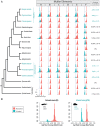Gene-rich X chromosomes implicate intragenomic conflict in the evolution of bizarre genetic systems
- PMID: 35653559
- PMCID: PMC9191650
- DOI: 10.1073/pnas.2122580119
Gene-rich X chromosomes implicate intragenomic conflict in the evolution of bizarre genetic systems
Abstract
Haplodiploidy and paternal genome elimination (HD/PGE) are common in invertebrates, having evolved at least two dozen times, all from male heterogamety (i.e., systems with X chromosomes). However, why X chromosomes are important for the evolution of HD/PGE remains debated. The Haploid Viability Hypothesis posits that X-linked genes promote the evolution of male haploidy by facilitating purging recessive deleterious mutations. The Intragenomic Conflict Hypothesis holds that conflict between genes drives genetic system turnover; under this model, X-linked genes could promote the evolution of male haploidy due to conflicts with autosomes over sex ratios and genetic transmission. We studied lineages where we can distinguish these hypotheses: species with germline PGE that retain an XX/X0 sex determination system (gPGE+X). Because evolving PGE in these cases involves changes in transmission without increases in male hemizygosity, a high degree of X linkage in these systems is predicted by the Intragenomic Conflict Hypothesis but not the Haploid Viability Hypothesis. To quantify the degree of X linkage, we sequenced and compared 7 gPGE+X species’ genomes with 11 related species with typical XX/XY or XX/X0 genetic systems, representing three transitions to gPGE. We find highly increased X linkage in both modern and ancestral genomes of gPGE+X species compared to non-gPGE relatives and recover a significant positive correlation between percent X linkage and the evolution of gPGE. These empirical results substantiate longstanding proposals for a role for intragenomic conflict in the evolution of genetic systems such as HD/PGE.
Keywords: genomic conflict; haplodiploidy; insects; sex chromosomes; sex determination.
Conflict of interest statement
The authors declare no competing interest.
Figures



Similar articles
-
Faster adaptation but slower divergence of X chromosomes under paternal genome elimination.Nat Commun. 2025 Jun 11;16(1):5288. doi: 10.1038/s41467-025-60114-8. Nat Commun. 2025. PMID: 40500283 Free PMC article.
-
Accelerated evolution of sex chromosomes in aphids, an x0 system.Mol Biol Evol. 2012 Feb;29(2):837-47. doi: 10.1093/molbev/msr252. Epub 2011 Oct 13. Mol Biol Evol. 2012. PMID: 21998277
-
The evolutionary dynamics of haplodiploidy: Genome architecture and haploid viability.Evolution. 2015 Nov;69(11):2971-8. doi: 10.1111/evo.12792. Epub 2015 Nov 2. Evolution. 2015. PMID: 26462452 Free PMC article.
-
Genomic conflict in scale insects: the causes and consequences of bizarre genetic systems.Biol Rev Camb Philos Soc. 2010 Nov;85(4):807-28. doi: 10.1111/j.1469-185X.2010.00127.x. Biol Rev Camb Philos Soc. 2010. PMID: 20233171 Review.
-
The evolution of alternative genetic systems in insects.Annu Rev Entomol. 2003;48:397-423. doi: 10.1146/annurev.ento.48.091801.112703. Epub 2002 Jun 4. Annu Rev Entomol. 2003. PMID: 12221039 Review.
Cited by
-
Faster adaptation but slower divergence of X chromosomes under paternal genome elimination.Nat Commun. 2025 Jun 11;16(1):5288. doi: 10.1038/s41467-025-60114-8. Nat Commun. 2025. PMID: 40500283 Free PMC article.
-
Recent Evolution of a Maternally Acting Sex-Determining Supergene in a Fly with Single-Sex Broods.Mol Biol Evol. 2023 Jul 5;40(7):msad148. doi: 10.1093/molbev/msad148. Mol Biol Evol. 2023. PMID: 37352554 Free PMC article.
-
k-mer approaches for biodiversity genomics.Genome Res. 2025 Feb 14;35(2):219-230. doi: 10.1101/gr.279452.124. Genome Res. 2025. PMID: 39890468 Free PMC article. Review.
-
Males That Silence Their Father's Genes: Genomic Imprinting of a Complete Haploid Genome.Mol Biol Evol. 2021 May 19;38(6):2566-2581. doi: 10.1093/molbev/msab052. Mol Biol Evol. 2021. PMID: 33706381 Free PMC article.
-
Two New Mitogenomes of Bibionidae and Their Comparison within the Infraorder Bibionomorpha (Diptera).Genes (Basel). 2023 Jul 21;14(7):1485. doi: 10.3390/genes14071485. Genes (Basel). 2023. PMID: 37510389 Free PMC article.
References
-
- Hamilton W. D., Extraordinary sex ratios. A sex-ratio theory for sex linkage and inbreeding has new implications in cytogenetics and entomology. Science 156, 477–488 (1967). - PubMed
-
- Hartl D. L., Brown S. W., The origin of male haploid genetic systems and their expected sex ratio. Theor. Popul. Biol. 1, 165–190 (1970). - PubMed
-
- Bull J. J., An advantage for the evolution of male haploidy and systems with similar genetic transmission. Heredity 43, 361–381 (1979).
Publication types
MeSH terms
LinkOut - more resources
Full Text Sources

